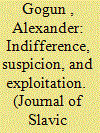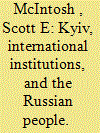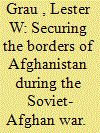|
|
|
Sort Order |
|
|
|
Items / Page
|
|
|
|
|
|
|
| Srl | Item |
| 1 |
ID:
139426


|
|
|
|
|
| Summary/Abstract |
While there has been a good deal of attention and scholarly research on the use of targeted killings by Israel and the United States, there has surprisingly not been as much focus on the use of this strategy by the Russian government. In the interest of filling this gap, I provide the first, to my knowledge, quantitative examination of the effectiveness of Russia’s use of targeted killings. Building off of Morehouse (forthcoming), I model the impact of Chechen leadership losses from targeted killings on the later number and severity of Chechen militant attacks between 2004 and 2011. I find that at best, targeted killings had no significant impact, and at worst, they led to increases in the number and severity of militant operations.
|
|
|
|
|
|
|
|
|
|
|
|
|
|
|
|
| 2 |
ID:
139430


|
|
|
|
|
| Summary/Abstract |
This article analyzes the impact of Germany’s late-war fortress strategy on both the German defensive conduct and Soviet offensive considerations. The strategy remains shrouded in obscurity, as most historians merely employ the — predominantly negative — opinions of German generals. Therefore, it has been dismissed as yet another example of the inadequacy of Hitler and the German High Command (OKH) to form a suitable defensive strategy. The purpose of this article is to balance this view and bring to light some of the lesser-known characteristics of the strategy. Festung Königsberg, present-day Kaliningrad, will be used as a case study. The developments in and around the city during the period between November 1944 and April 1945 contradict most of the prevailing assumptions about the strategy.
|
|
|
|
|
|
|
|
|
|
|
|
|
|
|
|
| 3 |
ID:
139431


|
|
|
|
|
| Summary/Abstract |
This article discusses the general relationship between Soviet partisans and the Shoah in Ukraine. This topic also touches upon the issue of the involvement of Jews in Soviet paramilitary, reconnaissance, sabotage and terrorist military units that were operating behind the Wehrmacht front lines. To a lesser extent, the context of these events is shown; in particular, the moods of the population on the occupied territories are described.
|
|
|
|
|
|
|
|
|
|
|
|
|
|
|
|
| 4 |
ID:
139427


|
|
|
|
|
| Summary/Abstract |
Joint Publication 1-02, Department of Defense Dictionary of Military and Associated Terms,defines instruments of national power as ‘All of the means available to the government in its pursuit of national objectives. They are expressed as diplomatic, economic, informational and military’. At the September 2014 Wales Summit, the Supreme Allied Commander in Europe described Russia’s recent use of one of these listed means as ‘the most amazing information warfare blitzkrieg we have ever seen in the history of information warfare’. The recent use of the Russian media to support this hybrid approach — via controlling the message, the narrative, and thus the perceptions of the Russian street regarding the nation’s aims — is evident to anyone with Internet access.
|
|
|
|
|
|
|
|
|
|
|
|
|
|
|
|
| 5 |
ID:
139432


|
|
|
|
|
| Summary/Abstract |
One of the topical problems in the history of the Second World War was the relations between the USSR and Turkey. The warring sides examined possible methods for Turkey to come over to their side. The Turkish issue was a main theme in the correspondence among the heads of the anti-Hitler coalition. Based on information from Soviet and Turkish periodicals and materials from the Russian Federation Foreign Policy Archive, we examine the features of Turkey’s foreign policy during the war and Turkey’s relations with the USSR. We examine the Teheran, Cairo, and Potsdam Conferences, where the leaders of the anti-Hitler coalition discussed the Turkish issue and Churchill’s proposal to open a second front on the territory of Turkey.
|
|
|
|
|
|
|
|
|
|
|
|
|
|
|
|
| 6 |
ID:
139433


|
|
|
|
|
| Summary/Abstract |
During the 1979–1989 Soviet-Afghan War, the Soviets provided training, advice, and support to the Border Guard forces of the Democratic Republic of Afghanistan. Afghanistan shared borders with the Soviet Union, China, Iran, and Pakistan. The Soviets addressed the Iranian, Chinese, and Pakistani borders as any nation assisting another nation would. Afghanistan’s border with the Soviet Union was different. The Soviet Union increased its own border forces facing Afghanistan while moving Soviet border forces well within Afghanistan, creating a de facto Soviet border inside their neighboring country. The Afghan government ignored this challenge to national sovereignty. The Soviet border force was more than stationary outposts. It had ground maneuver and air assault battalions which swept the area in search of guerrillas.
|
|
|
|
|
|
|
|
|
|
|
|
|
|
|
|
| 7 |
ID:
139428


|
|
|
|
|
| Summary/Abstract |
Broken down by occupation, more American journalists worked clandestinely for Soviet intelligence in the United States during the early 1940s than in any other profession except engineering. However, since reporters had no direct access to government secrets, most research focuses on their role as messengers, recruiters, and sources of inside information. While not discounting these roles, this article argues that journalist spies also collected a large amount of secret diplomatic and military information. Covering the years 1941 through 1946, this article also shows that the information collected by these spies evolved as World War II morphed into the Cold War.
|
|
|
|
|
|
|
|
|
|
|
|
|
|
|
|
| 8 |
ID:
139429


|
|
|
|
|
| Summary/Abstract |
Iurko Tiutiunnyk was the second most important Ukrainian military figure after Symon Petliura during the Russian Civil War. However, between 1914 and 1922, he fought for a number of different masters: the tsar, the warlord Nechypir Hryhor’iev, the All-Ukrainian Revolutionary Committee, and the Army of the Ukrainian People’s Republic; in 1923 he had to reconcile himself to the Bolshevik regime after being tricked into returning to the Soviet Ukraine. In order to justify his repeated changes in loyalty, he constructed and projected several different personae. This article charts this process, suggesting that the opportunities and pressures driving Tiutiunnyk’s adoption of new identities made him typical of his generation of Ukrainian military and political actors.
|
|
|
|
|
|
|
|
|
|
|
|
|
|
|
|
|
|
|
|
|